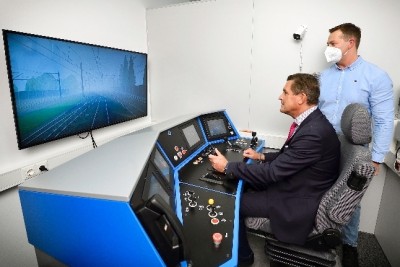Vienna's "Traincademy" Uses Modern Simulators and VR for Driver and Rail Jobs Training
The new Traincademy in Vienna offers training courses for train drivers and other rail jobs using modern simulators and VR technology. With some estimating that thousands of rail employees will be needed in the coming years in Austria alone, the Traincademy wants to offer high-quality training to those looking for careers in the industry. Read more about the new Traincademy and the future of the rail industry.
 Vienna City Councilor Peter Hanke (left) using one of the train simulators at the Traincademy. / Picture: © WLB / Zinner
Vienna City Councilor Peter Hanke (left) using one of the train simulators at the Traincademy. / Picture: © WLB / Zinner
In the next few years, several thousand employees will be needed in the passenger and freight rail sector in Austria alone. In Vienna, a modern training center for rail jobs has now gone into operation.
The “Traincademy” is a joint project of Wiener Lokalbahnen (WLB) and its freight transport subsidiary Wiener Lokalbahnen Cargo (WLC), which operates throughout Europe.
Managing Director of WLB Monika Unterholzner and Managing Director of WLC Bernd Müller both explain that the railroad industry is looking for highly qualified employees and that the Traincademy is aiming to become a top training address for those seeking careers in this industry.
Regarding the Traincademy, City Councilor for Finance and Economic Affairs Peter Hanke said, “Railway professions are jobs of the future with great opportunities and exciting job prospects. Rail companies are desperately looking for train drivers and other specialists. At the Traincademy, we are training future specialists with state-of-the-art technology.”
Diverse training opportunities
The Traincademy offers a wide range of training courses for railroad professions. In addition to complete training for train drivers, the training facility offers numerous other courses.
These include, for example, courses for locomotive drivers from abroad in order to be allowed to drive on the ÖBB network, training courses on vehicle safety, or courses on shunting.
Training courses for train dispatchers, train planners, or other key professions in the railroad industry are also planned.
The Wiener Lokalbahnen Group uses the Traincademy for internal training and further education of its employees in freight and passenger transport. At the same time, the training facility is also open to external railroad companies and their employees.
Modern simulators and VR technology used in training
The Traincademy relies heavily on digitalization in its training. Two modern train simulators support future train drivers in their training.
The simulator can be used for realistic training that can practically never be simulated in real operation or that is very time-consuming and costly. For example, the correct behavior in the event of technical faults, a defective contact line, a blocked line, or infrastructural damage.
In addition, modern virtual reality technologies are being used in railroad training for the first time in Austria. Thanks to VR goggles, students learn about vehicle technology in a resource-saving and modern way, experience aspects of occupational safety, or even experience driving scenes realistically in training.
WLC: Freight transport from Hamburg to Trieste
WLC operates in a total of seven European countries and serves around 20 European transshipment hubs, including major commercial hubs such as Hamburg, Rotterdam, Duisburg, and Trieste. With around 130 employees, WLC transports more than five million tons of goods through Europe every year.
Rail transport as a factor for climate protection
The expansion of rail transport is a key factor in achieving climate protection targets.
About 95 percent of CO2 emissions from the entire transport sector in the EU are caused by car and truck traffic.
Less than five percent is accounted for by public passenger transport, bus, streetcar, metro and rail passenger, and freight transport.
Therefore, the potential for saving CO2 emissions is enormous, as the entire transport sector is responsible for around a quarter of EU-wide greenhouse gas emissions.
Freight transport by road causes around 15 times more emissions than transport by rail.
Rail is also efficient and environmentally friendly when it comes to passenger transport.
Compared to traveling by car, a commuter using the Badner Bahn saves over 1600 kilograms of CO2 per year on the route from Baden to Vienna.



